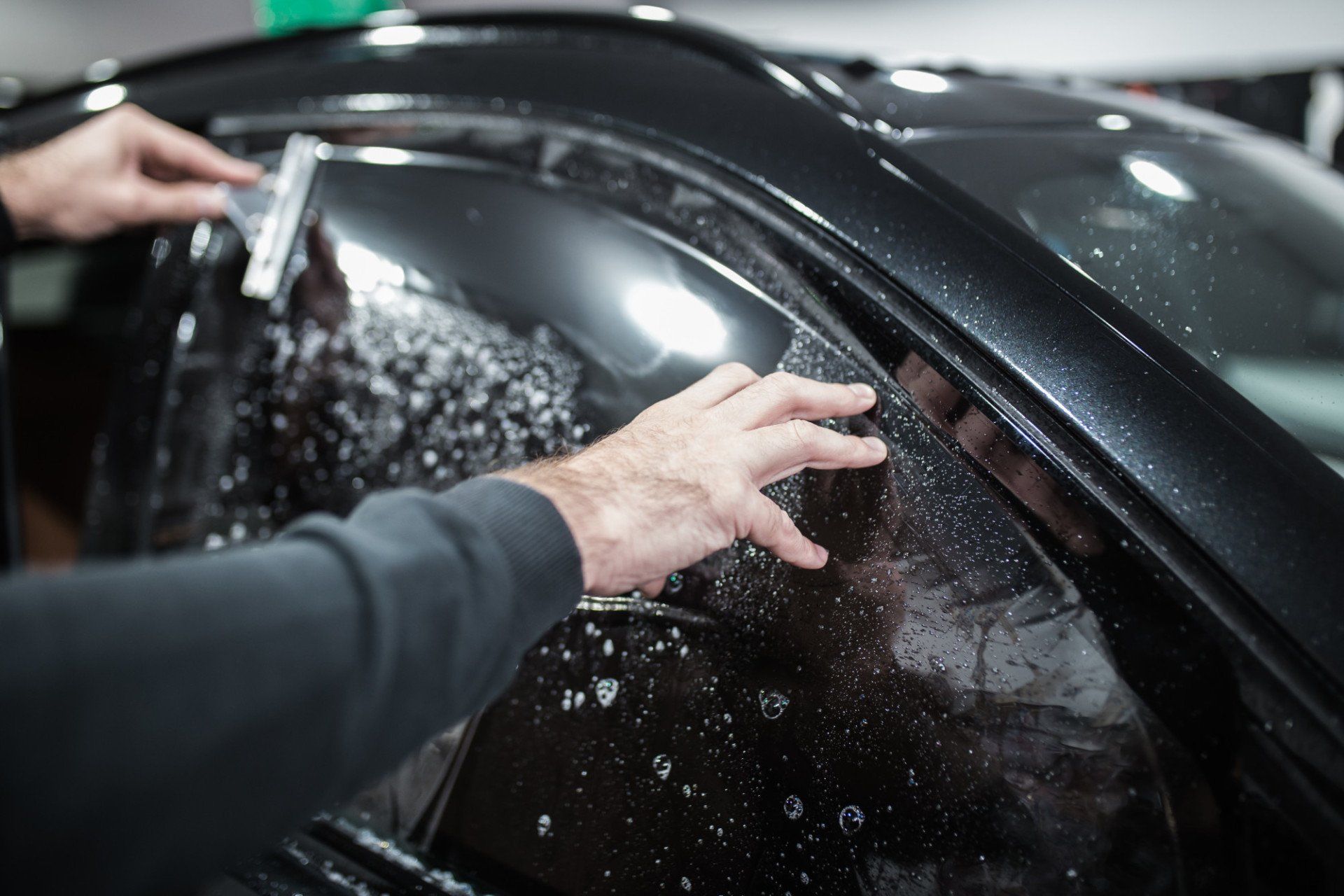Whatever You Need to Understand About Auto Home Window Tinting for Your Car
Auto home window tinting is a useful improvement for numerous vehicle owners. It offers benefits such as increased comfort and power efficiency. Numerous tint movies deal with different needs and choices. Nonetheless, understanding legal laws and choosing the best tint percentage is vital. The installation process and correct maintenance also play considerable roles in making sure the long life of the tint. What various other variables should one consider prior to choosing on window tinting?
Advantages of Auto Home Window Tinting
Although some vehicle owners may forget it, car window tinting deals countless benefits that improve both the driving experience and the lorry's long life. Among the primary advantages is the decrease of warm build-up inside the lorry, permitting for a more comfortable trip, particularly during heat. This can cause decreased reliance on air conditioning, improving gas efficiency.Additionally, home window tinting supplies security against unsafe UV rays, which can cause skin damages and discolor indoor products gradually. By blocking these rays, the tint helps protect the vehicle's interior and maintain its resale value.Moreover, tinted windows can improve privacy and safety, as they make it harder for outsiders to see inside the car. This added layer of protection can hinder potential theft. Overall, vehicle window tinting serves as a practical financial investment that adds to both comfort and the vehicle's overall well-being.
Kinds of Window Color Films
When taking into consideration automobile window tinting, car proprietors encounter a selection of window tint movies, each designed to meet details demands and preferences. The first category is dyed home window film, which offers a basic level of personal privacy and UV security while being affordable. Next off, metalized movies integrate tiny metal particles, mirroring heat and boosting toughness, although they may disrupt electronic signals.Ceramic movies are another choice, known for their remarkable heat being rejected and quality, supplying high performance without signal disturbance. Hybrid movies incorporate features of dyed and metalized films, striking a balance in between price and functionality. Each kind of window tint movie offers distinct benefits, enabling lorry proprietors to pick based on their specific demands, such as warmth control, budget plan, and appearance considerations. Comprehending these choices is essential for making an informed decision regarding car window tinting.
Understanding Legal Laws
When thinking about automobile home window tinting, it is critical to recognize the lawful regulations that regulate tint darkness limits and windshield tint needs. These laws can differ substantially from one state to another, impacting what is permissible for vehicle proprietors. Familiarizing oneself with these laws warranties compliance and aids stay clear of potential fines or penalties.
Color Darkness Limits
Exactly how can car owners guarantee they stay compliant with local laws relating to home window tinting? Comprehending color darkness limitations is vital. Each state has particular policies that determine the permitted levels of darkness for window colors, which are gauged by Visible Light Transmission (VLT) portions. Typically, front-side windows have to allow a greater portion of light compared to back windows. For example, some states might allow just 30% VLT for front windows, while the back home windows could be permitted to have especially darker tints. To ensure conformity, automobile owners must consult state guidelines or neighborhood police for precise info. Additionally, licensed tinting specialists can supply insights regarding lawful limitations, guaranteeing that lorry owners make notified decisions.
Windshield Tint Laws

State-Specific Regulations
Steering with the landscape of state-specific legislations relating to vehicle window tinting needs mindful attention to information, as regulations can differ considerably from one state to an additional. Each state has its very own collection of policies controling allowed tint portions, kinds of products, and positioning on lorry home windows. As an example, some states allow darker colors on back windows while restricting them on front windows, while others have more stringent total restrictions. In addition, certain states mandate the use of details products or call for certification from installers. Failing to follow these laws can cause fines or the necessity to get rid of non-compliant color. Vehicle owners need to consult their state's Division of Motor Vehicles or pertinent authority to ensure adherence to local regulations.
Selecting the Right Tint Portion
When selecting the appropriate tint percentage for a lorry's windows, one must take into consideration different elements that affect both appearances and performance. Tint percentages normally range from 5% to 70%, with reduced percentages supplying darker tones and higher percents allowing much more light in. A darker tint can boost privacy and minimize glare, while a lighter color can keep exposure and abide by legal restrictions.Furthermore, personal choice plays a considerable duty in this choice. Some individuals might prefer the smooth look of darker tints, while others may prefer a much more open, ventilated feeling. In addition, the car's objective must be taken right into account; as an example, those utilizing their lorries for commercial functions may go with lighter tints to keep an expert look.Ultimately, the right color percent balances individual style, comfort, and adherence to regional guidelines, making sure a rewarding tinting experience.
The Setup Refine
A successful setup of window tint needs cautious interest to detail and the right tools. The process generally begins with extensive cleaning of the windows to eliminate dirt, debris, and dust, assuring correct attachment of the film. As soon as the surface areas are prepared, the installer procedures and cuts the tint film to fit each window accurately.Next, the film is placed on the glass, usually utilizing a solution to assist in easy change and prevent air bubbles. Heat is in some cases related to the film to adhere it to the window's curves, boosting its look and durability. After confirming a smooth fit, the installer diligently trims any type of excess film along the edges.Finally, the installer checks for flaws and verifies all edges are safe and secure. This careful technique is important not just for aesthetic appeals yet also for achieving the preferred performance advantages of home window tinting, such as UV security and heat decrease.
Upkeep and Take Care Of Tinted Windows
Proper maintenance and treatment are necessary for maintaining the integrity of tinted home windows. Efficient cleansing strategies, the evasion of unsafe chemicals, and regular inspections for damage play vital roles in making certain longevity. By adhering to these guidelines, vehicle owners can keep the visual and useful advantages of their home window color.
Cleaning Techniques for Color
Keeping the clarity and durability of colored windows calls for particular cleansing techniques tailored to the film's delicate surface area. It is necessary to utilize a soft microfiber towel to prevent scratching the tint while cleansing. A gentle remedy of water and a few decreases of light recipe soap can successfully remove dirt and grime. It is a good idea to apply the cleansing solution to the towel, instead of straight onto the colored surface, to avoid wetness from leaking right into the sides of the film. Mild, round activities need to be employed to cleanse the home windows thoroughly. Regular cleansing helps maintain visibility and avoids accumulation, guaranteeing that the color continues to be in prime condition over time. Following these methods will prolong the life of tinted home windows.
Staying Clear Of Dangerous Chemicals
Although many family cleansing items are reliable on different surface areas, they can position significant threats to tinted windows. Chemicals such as ammonia, bleach, and specific solvents can degrade the tint movie, resulting in staining and peeling. Individuals ought to decide for pH-balanced cleaners especially created for colored home windows. Furthermore, making use of soft microfiber towels will certainly help avoid scrapes and keep the tint's honesty. Regular upkeep is crucial; as a result, preventing rough scrubbing up or rough materials is necessary. It is a good idea to review product labels very carefully to validate compatibility with window tints. By choosing the right cleaning solutions and tools, automobile proprietors can preserve the look and performance of their colored windows, guaranteeing a much longer life-span and peak performance.
Inspecting for Damages
Regular evaluations of tinted windows are very i was reading this important for identifying any kind of indications of damage that may jeopardize their efficiency and look. Owners need to look for gurgling, peeling off, or discoloration, as these issues can suggest poor setup or exposure to unsafe components. It is advisable to check the sides of the movie where peeling off may start and inspect for any type of scratches that can impact visibility. Additionally, page ultraviolet (UV) rays can create the color to degrade in time, so checking its efficiency in blocking UV light is critical. If any type of damages is spotted, punctual activity must be taken, which might consist of expert repair service or replacement. Preserving colored home windows not just enhances looks but also warranties proceeded defense for both passengers and the lorry inside.
Typical Myths About Home Window Tinting
What misconceptions border window tinting for cars? Numerous individuals believe that all home window colors are illegal, yet policies vary by state, enabling specific degrees of tinting. One more typical myth is that darker colors block even more heat; nevertheless, the efficiency of home window movies depends upon their technology rather than darkness. Some individuals also believe that window tinting is exclusively for aesthetic appeals, forgeting its benefits, such as UV protection and glare decrease. Additionally, several assume that window tinting will harm their car's glass, but professionally applied tints can really enhance glass longevity. There is an idea that window colors block exposure, yet high-quality movies are made to preserve clear sightlines while supplying privacy. Understanding these myths helps consumers make informed choices pertaining to home window tinting, ensuring they appreciate the full variety of advantages it provides.
Frequently Asked Concerns
For How Long Does Window Tinting Commonly Last?
The durability of home window tinting varies based upon factors such as installation top quality, movie kind, and environmental problems. Typically, premium color can last anywhere from 5 to ten years prior to requiring substitute or reapplication.
Can I Eliminate Home Window Tint Myself?
Removing window tint oneself is feasible, though it may be challenging. People ought to utilize a warmth source and glue cleaner to reduce the process, however caution is advised to avoid harming the car's glass or interior.
What Tools Are Needed for DIY Window Tinting?

Will Window Tinting Damage My Vehicle's Glass?
Home window tinting, when applied correctly, typically does not harm a car's glass. Nevertheless, improper setup or low-quality films may result in peeling off, bubbling, or scratching, possibly endangering the integrity of the glass in time.
Can Tinted Windows Influence My Automobile's Resale Worth?
The influence of tinted home windows on a vehicle's resale value can differ. While some customers appreciate the added privacy and UV security, others may view it as a prospective problem, potentially impacting resale Click Here positively or adversely. When considering car home window tinting, vehicle proprietors experience a selection of home window color films, each created to fulfill certain demands and preferences. When taking into consideration automobile home window tinting, it is critical to understand the lawful guidelines that regulate tint darkness limits and windshield tint demands. Commonly, front-side home windows need to enable a greater percent of light contrasted to rear home windows. Some states might allow only 30% VLT for front home windows, while the rear windows may be permitted to have especially darker colors. Some states permit darker tints on rear home windows while prohibiting them on front home windows, while others have stricter overall limits.